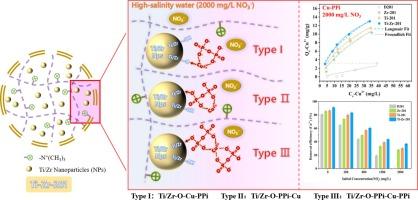当前位置:
X-MOL 学术
›
Sep. Purif. Technol.
›
论文详情
Our official English website, www.x-mol.net, welcomes your
feedback! (Note: you will need to create a separate account there.)
Enhanced copper pyrophosphate complex removal from high salty wastewater by using nanoconfined Ti-Zr binary metallic oxides: Multivariate complexation mechanism
Separation and Purification Technology ( IF 8.1 ) Pub Date : 2024-11-18 , DOI: 10.1016/j.seppur.2024.130588 Yu Hu, Xin Li, Xiaolin Zhang, Weiming Zhang, Bingcai Pan, Ming Hua
Separation and Purification Technology ( IF 8.1 ) Pub Date : 2024-11-18 , DOI: 10.1016/j.seppur.2024.130588 Yu Hu, Xin Li, Xiaolin Zhang, Weiming Zhang, Bingcai Pan, Ming Hua

|
The salt ions (typically > 1000 mg/L) present in copper plating wastewater limit the application of ion exchange in the deep treatment of copper complexes (such as copper-pyrophosphate (Cu-PPi)). Metal nanoparticle immobilization is an effective method, and bimetallic nanoparticles have more potential than monometallic ones. In this study, bimetallic nanocomposite Ti-Zr-201 was successfully synthesized by confining Ti-Zr oxide nanoparticles in the pores of anion exchange polymer (D201). The obtained new adsorbent Ti-Zr-201 with bimetallic doped structure had more active sites (7.22 mmol/g), higher hydroxyl content (3.51 × 1022 OH/ nm2) and larger specific surface area (31.65 m2/g) than monometallic nanocomposite adsorbents (Zr-201 and Ti-201). The results showed that Ti-Zr-201 has better Cu-PPi adsorption capacity (24.82 mg Cu/g) than Zr-201 (21.48 mg Cu/g) and Ti-201 (21.71 mg Cu/g) in the high salt water (2000 mg/L NO3–). Further mechanistic studies revealed that Cu-PPi removal as a whole was mainly realized via ternary complexation (Ti/Zr-O-Cu-PPi of Type-A, Ti/Zr-O-PPi-Cu of Type-B) and quaternary complexation (Ti/Zr-O-PPi-Cu-PPi of Type-B) both formed during the adsorption. The saturated Ti-Zr-201 can be regenerated more than 90% rapidly and had good stability. Moreover, the novel adsorbent also had a excellent removal effect on several other phosphorous copper complexes (tripolyphosphate, methyl dihydrogen phosphate, etc.). Therefore, the nanocomposite Ti-Zr-201 exhibited promising application on the deep removal of complex-state Cu with phosphorus ligands from high salty wastewater.
中文翻译:

利用纳米限域 Ti-Zr 二元金属氧化物增强高盐废水焦磷酸铜络合物去除:多元络合机理
镀铜废水中存在的盐离子(通常为 > 1000 mg/L)限制了离子交换在铜络合物(如焦磷酸铜 (Cu-PPi)))的深处理中的应用。金属纳米颗粒固定化是一种有效的方法,双金属纳米颗粒比单金属纳米颗粒具有更大的潜力。在本研究中,通过将 Ti-Zr 氧化物纳米颗粒限制在阴离子交换聚合物 (D201) 的孔隙中,成功合成了双金属纳米复合材料 Ti-Zr-201。与单金属纳米复合吸附剂(Zr-201 和 Ti-201)相比,所得的双金属掺杂结构新型吸附剂 Ti-Zr-201 具有更多的活性位点 (7.22 mmol/g)、更高的羟基含量 (3.51 × 1022 OH/ nm2) 和更大的比表面积 (31.65 m2/g)。结果表明,Ti-Zr-201在高盐水(2000 mg/L NO3–)中的吸附容量(24.82 mg Cu/g)优于Zr-201(21.48 mg Cu/g)和Ti-201(21.71 mg Cu/g)。进一步的机理研究表明,Cu-PPi 整体的去除主要通过吸附过程中形成的三元络合 (Ti/Zr-O-Cu-PPi, Ti/Zr-O-PPi-Cu-PPi) 和四元络合 (Ti/Zr-O-PPi-B型的 Cu-PPi) 来实现。饱和的 Ti-Zr-201 可快速再生 90% 以上,稳定性好。此外,这种新型吸附剂对其他几种磷铜络合物(三聚磷酸盐、磷酸二氢甲酯等)也具有极好的去除效果。因此,纳米复合材料 Ti-Zr-201 在从高盐废水中深度去除含磷配体的复杂态 Cu 方面表现出有前途的应用。
更新日期:2024-11-20
中文翻译:

利用纳米限域 Ti-Zr 二元金属氧化物增强高盐废水焦磷酸铜络合物去除:多元络合机理
镀铜废水中存在的盐离子(通常为 > 1000 mg/L)限制了离子交换在铜络合物(如焦磷酸铜 (Cu-PPi)))的深处理中的应用。金属纳米颗粒固定化是一种有效的方法,双金属纳米颗粒比单金属纳米颗粒具有更大的潜力。在本研究中,通过将 Ti-Zr 氧化物纳米颗粒限制在阴离子交换聚合物 (D201) 的孔隙中,成功合成了双金属纳米复合材料 Ti-Zr-201。与单金属纳米复合吸附剂(Zr-201 和 Ti-201)相比,所得的双金属掺杂结构新型吸附剂 Ti-Zr-201 具有更多的活性位点 (7.22 mmol/g)、更高的羟基含量 (3.51 × 1022 OH/ nm2) 和更大的比表面积 (31.65 m2/g)。结果表明,Ti-Zr-201在高盐水(2000 mg/L NO3–)中的吸附容量(24.82 mg Cu/g)优于Zr-201(21.48 mg Cu/g)和Ti-201(21.71 mg Cu/g)。进一步的机理研究表明,Cu-PPi 整体的去除主要通过吸附过程中形成的三元络合 (Ti/Zr-O-Cu-PPi, Ti/Zr-O-PPi-Cu-PPi) 和四元络合 (Ti/Zr-O-PPi-B型的 Cu-PPi) 来实现。饱和的 Ti-Zr-201 可快速再生 90% 以上,稳定性好。此外,这种新型吸附剂对其他几种磷铜络合物(三聚磷酸盐、磷酸二氢甲酯等)也具有极好的去除效果。因此,纳米复合材料 Ti-Zr-201 在从高盐废水中深度去除含磷配体的复杂态 Cu 方面表现出有前途的应用。


















































 京公网安备 11010802027423号
京公网安备 11010802027423号